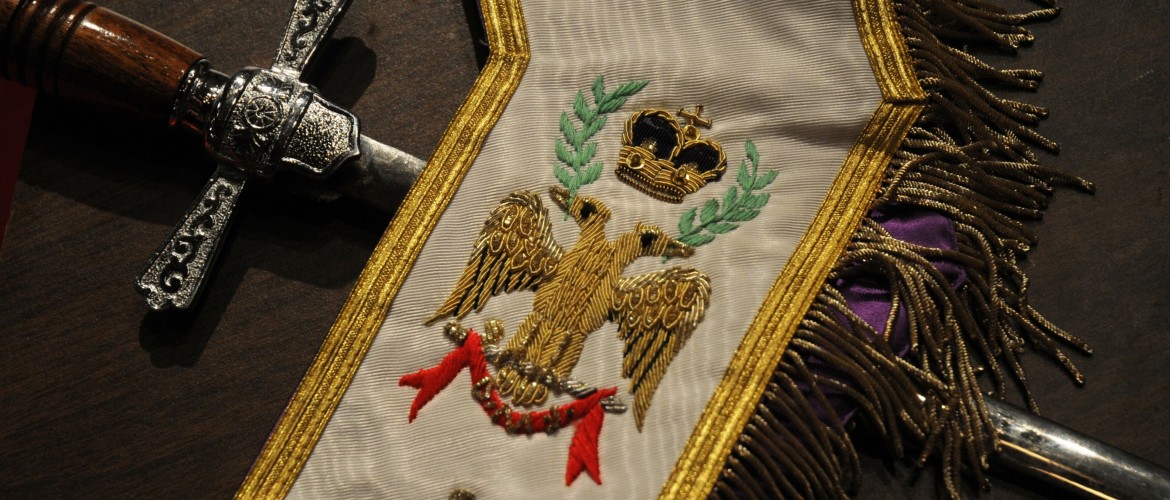Scottish Rite Masonry began in Cumberland on November 13, 1899, with the first meeting of Meredith Lodge of Perfection No. 3. On October 20, 1955, the Supreme Council changed Meredith Lodge, Kedron Chapter Knights Rose Croix, and Potomac Council Knights Kadosh to Cumberland Cumberland Lodge of Perfection, Cumberland Chapter Knights Rose Croix, and Cumberland Council Knights Kadosh, respectively.
The Ancient and Accepted Scottish Rite of Freemasonry, commonly known as simply the Scottish Rite, is one of several Rites of Freemasonry. A Rite is a progressive series of degrees conferred by various Masonic organizations or bodies, each of which operates under the control of its own central authority. In the Scottish Rite the central authority is called a Supreme Council.
The Scottish Rite is one of the appendant bodies of Freemasonry that a Master Mason may join for further exposure to the principles of Freemasonry. In the United States the Scottish Rite is officially recognized by Grand Lodges as an extension of the degrees of Freemasonry. The Scottish Rite builds upon the ethical teachings and philosophy offered in the craft lodge, or Blue Lodge, through dramatic presentation of the individual degrees.
The thirty-three degrees of the Scottish Rite are conferred by several controlling bodies. The first of these is the Craft Lodge which confers the Entered Apprentice, Fellowcraft, and Master Mason degrees. Craft lodges operate under the authority of Grand Lodges, not the Scottish Rite. Although most lodges throughout the English-speaking world do not confer the Scottish Rite versions of the first three degrees, there are a handful of lodges in New Orleans and in several other major cities that have traditionally conferred the Scottish Rite version of these degrees.
After the organization of the Grand Lodge of England in 1717, Masonry became very popular. It passed over the Channel to France in 1725 where many ritualists invented numerous “side degrees” subject to no governing body and hawked them about the country and through the continent.
In 1740, Chevalier Ramsey, a Scottish nobleman, gave some famous lectures in Paris and Bordeux on the origin and objects of Masonry. He subdivided the “Three Degrees” and concocted degrees from the parts explained by his philosophic lectures. He established a Lodge which he called Harodim, but the French styled it Scotchman’s Lodge Masonry, which in fact may have had something to do with this misnomer, Scottish Rite. Mackey says, no part of the Scottish Rite was originated in Scotland with the possible exception of the Royal Order of Scotland.
The Scottish Rite has its beginning in France. In 1754, the Chevalier de Bonneville established in the College of Clermont in Paris a chapter of twenty-five so-called High Degrees. This college was a sort of refuge for the Stuarts of Scotland, which in fact may have had some bearing on the name, Scottish Rite. The Body established by Bonneville, including the symbolic degrees, was called the Rite of Perfection. In 1758, these degrees were taken by Marquis de Lemais to Berlin, where they in the following year were placed under a body called the Council of the Emperors of the East and West, which was formed at Paris from the ruins of the Clermont Chapter.
In 1762, it is said that Fredrick the Great “formed and promulgated” what is known as the Constitutions of 1762. In 1786, a reorganization took place in which eight degrees were added to the twenty-five and the name changed to the Ancient and Accepted Scottish Rite of Freemasonry. By three Constitutions, Fredrick resigned the authority of Grand Commander, which title he had held since the adoption of the Grand Constitutions in 1972, and deposited his Masonic Prerogatives with a council in each nation to be composed of Sovereign Grand Inspectors General of the Thirty-Third and last degree of Freemasonry.

